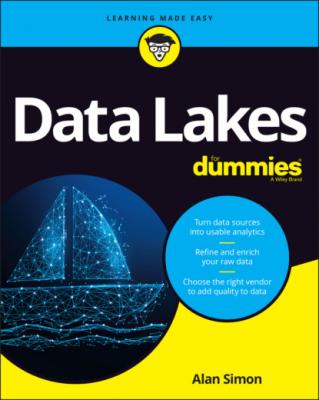Data Lakes For Dummies. Alan R. Simon
Чтение книги онлайн.
Читать онлайн книгу Data Lakes For Dummies - Alan R. Simon страница 13
 a minute! Why in the world do you need to copy data into your data lake? Why can’t you just analyze the data right where it is, in the source applications and their databases?
a minute! Why in the world do you need to copy data into your data lake? Why can’t you just analyze the data right where it is, in the source applications and their databases?
Data lakes, at least as you need to build them today and for the foreseeable future, are a continuation of the same model that has been used for data warehousing since the early 1990s. For many technical reasons related to performance, deep analysis involving large data volumes and significant cross-referencing directly in your source applications isn’t a workable solution for the bulk of your analytics.
Consequently, you need to make copies of the operational data that you want for analytical purposes and store that data in your data lake. Think of the data inside your data lake as (in used-car terminology) previously owned data that has been refurbished and is now ready for a brand-new owner.
But if you can’t adequately do complex analytics directly from source applications and their databases, what about this idea: Run your applications off your data lake instead! This way, you can avoid having to copy your data, right? Unfortunately, that idea won’t work, at least with today’s technology.
Many vendors are working on new technology that will allow you to build a data lake for operational, as well as analytical purposes. This technology is still a bit down the road from full operational viability. For the time being, you’ll build a data lake by copying data from many different source applications.
Refilling the data lake
What exactly does “copying data” look like, and how frequently do you need to copy data into the data lake?
With ELT, you can control the latency, or “freshness,” of data that is brought into the data lake. Some data needed for critical, real-time analysis can be streamed into the data lake, which means that a copy is sent to the data lake immediately after data is created or updated within a source application. (This is referred to as a low-latency data feed.) You essentially push data into your data lake piece by piece immediately upon the creation of that data.
Other data may be less time-critical and can be “batched up” in a source application and then periodically transmitted in bulk to the data lake.
You can specify the latency requirements for every single data feed from every single source application.
Everyone visits the data lake
Take a look around your organization today. Chances are, you have dozens or even hundreds of different places to go for reports and analytics. At one time, your company probably had the idea of building an enterprise data warehouse that would provide data for almost all the analytical needs across the entire company. Alas, for many reasons, you instead wound up with numerous data marts and other environments, very few of which work together. Even enterprise data warehouses are often accompanied by an entire portfolio of data marts in the typical organization.
Great news! The data lake will finally be that one-stop shopping place for the data to meet almost all the analytical needs across your entire enterprise.
Enterprise-scale data warehousing fell short for many different reasons, including the underlying technology platforms. Data lakes overcome those shortfalls and provide the foundation for an entirely new generation of integrated, enterprise-wide analytics.
The Data Lake Olympics
Suppose you head off for a weeklong vacation to your favorite lake resort. The people who run the resort have divided the lake into different zones, each for a different recreational purpose. One zone is set aside for water-skiing; a second zone is for speedboats, but no water-skiing is permitted in that zone; a third zone is only for boats without motors; and a fourth zone allows only swimming but no water vessels at all.
The operators of the resort could’ve said, “What the heck, let’s just have a free-for-all out on the lake and hope for the best.” Instead, they wisely established different zones for different purposes, resulting in orderly, peaceful vacations (hopefully!) rather than chaos.
A data lake is also divided into different zones. The exact number of zones may vary from one organization’s data lake to another’s, but you’ll always find at least three zones in use — bronze, silver, and gold — and sometimes a fourth zone, the sandbox.
Bronze, silver, and gold aren’t “official” standardized names, but they are catchy and easy to remember. Other names that you may find are shown in Table 1-1.